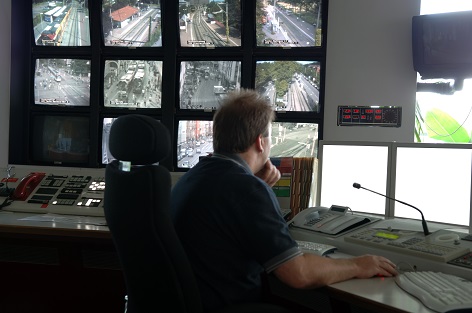Much attention has been directed recently towards the need of national network operators to enhance the capacity of their long-haul networks in order to deliver data-heavy services, such as streaming high-definition video services to a large broadband subscriber base. A significant part of overcoming bottlenecks is the deployment of 100 Gb/s, and increasingly 200 Gb/s, transceivers employing coherent detection technology. However, it must not be overlooked that not every network operator is in exactly the same business. Many private network owners have more modest data requirements to transport, albeit over perhaps several hundreds of kilometres.
For instance, several branches of government deploy long-distance optical networks for the purpose of monitoring activity along their length. One such objective is for the military to monitor across vast and possibly remote borders operated by a limited number of security posts. Military operations need to perform real-time monitoring of border activity between the manned posts in order to respond quickly to any breach. Cameras may be stationed at positions across the border and low-resolution images transmitted from post to post to alert forces to a threat as soon as it is perceived. The data requirements of this application can be supported by just a few channels operating at 10Gb/s, so no performance or cost benefit is achieved from upgrading to 100Gb/s transmission.

Another application requiring continuous monitoring over hundreds of kilometres is along the main road network of a country or region. Highway agencies are responsible for the smooth and continuous flow of vehicles and monitoring can be achieved by regularly spaced cameras transmitting low-resolution images back to a control centre. The control centre can use the data to identify major incidents that require emergency vehicles to be dispatched or employ lane management to optimise traffic flow at busy times. Again, a few channels operating at 10Gb/s can be sufficient for this application.
The ample spare capacity on the network may be leased to commercial telecoms service providers, thereby delivering an additional income stream to the agency operating the network. Where a mixture of both light and heavy data requirements is envisaged, a hybrid cable containing both G.655 and low-loss G.652 fibre products may be considered. This type of cable is particularly suited to the private operator whose own data transport requirements are light, but who may wish to lease capacity to other operators with more data-heavy demands.
A third example of an organisation that might choose to run their own private network is that of a power utility company. The utility can transmit its employee voice, mail, and internet communications, video for site security monitoring, and data generated by plant equipment for scrutiny of operational efficiency and safety. Power utilities may feel they cannot afford to share their network with other agencies so that full availability is maintained in an emergency situation, such as an earthquake that threatened the integrity of an electricity generating plant. This is another condition where a few channels operating at 10Gb/s can provide the network owner with all the capacity they require.
The intended application will, naturally, influence the selection of optical fibre. The workhorse of the previous decade, 10Gb/s transmission is achieved through direct-detection modulation schemes, both non-return to zero (NRZ), and return to zero (RZ). The accumulation of chromatic dispersion is still the primary consideration when selecting fibre for networks carrying signals using on these protocols. Chromatic dispersion occurs because different frequencies, or wavelengths, of light travel at slightly different speeds down the fibre, which causes signals to spread out as they travel. Using conventional standard singlemode fibre complying to ITU-T Recommendation G.652, dispersion compensating modules (DCMs) are required at the end of each 80–100km span in order to correct the signal broadening caused by accumulated chromatic dispersion in the C-band around 1550nm.
Non-zero dispersion-shifted fibres (NZ-DSF) are designed with a higher zero-dispersion wavelength, consequently giving a significantly lower dispersion around 1550nm. ITU-T Recommendations G.655 and G.656 describe different categories of NZ-DSF. In the case of G.656, the chromatic dispersion at 1550nm is reduced by about 50 per cent compared to conventional G.652 fibre, whereas a G.655-compliant product provides a remarkable 75 per cent reduction in chromatic dispersion at 1550nm. In a basic deployment with NRZ modulation, G.655 fibre can extend the reach out to 350km before DCMs need to be introduced. Even with the additional reach provided by G.555 fibre, it is desirable to reduce or even eliminate the amount of in-line dispersion compensation because DCMs add loss to the network, which must be compensated for by optical amplification. When combined with other technologies such as duo-binary modulation and receiver-based electronic dispersion compensation, distances of 1500km have been demonstrated without use of in-line DCMs.
Alternatively, for applications requiring transmission of just a few 10Gb/s channels, a simple transceiver-only network design can be cost-effective. A small form-factor pluggable (SFP) transceiver complying with 10GBASE-ER can send signals at 1550nm across 40km of G.652 fibre before the dispersion limit is reached and regeneration is required. For low channel counts, using these inexpensive devices to regenerate the signal can be more cost-effective than deploying optical amplifiers. Replacing standard singlemode fibre with low-dispersion G.655 fibre extends the reach until the receiver sensitivity threshold is reached. This limit is determined by the attenuation of the fibre, and so deployment of G.655 fibre potentially doubles the regeneration distance in this scenario.
The take-home message for network owners should be that there is no single fibre product to cover every application scenario. The selection of optical fibre type for long-distance transmission depends greatly on the application that the network owner is looking to support. A national service provider supporting a large base of broadband subscribers may elect to benefit from 100Gb/s technology, and thereby select a fibre with very low attenuation. This improves the optical signal-to-noise ratio (OSNR) of the transmission; such an approach will mitigate reach limitations in case an upgrade to 200Gb/s is considered in the future. Alternatively, a network operator finding sufficient capacity from 10Gb/s operation may derive the best cost position from a low-dispersion G.655 fibre, taking advantage of the reduced need for dispersion compensation and amplification costs. A hybrid cable containing both G.655 and G.652 fibre provides the best of both worlds, where the core application of the network owner requires a relatively low rate of data transmission whilst still allowing dark fibre to be leased to other operators wanting to support more data-intensive applications.
• Ian Davis is regional marketing manager EMEA for Corning


